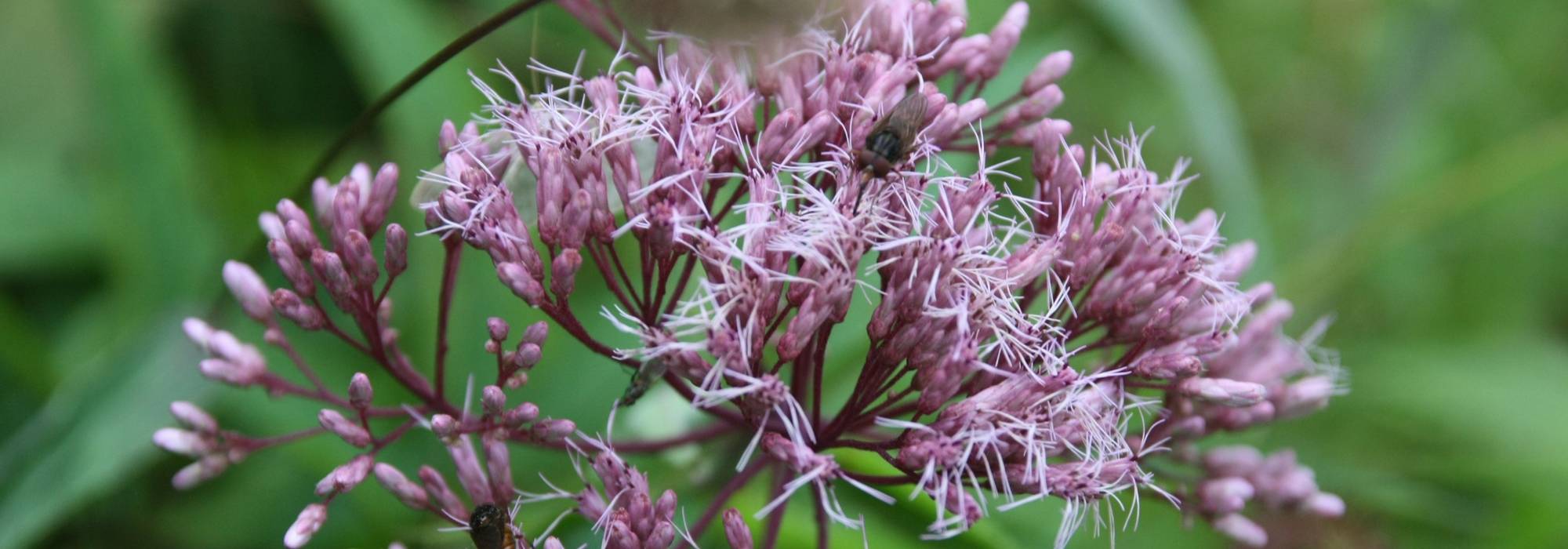
Eupatorium, gravel root : planting, growing and care
Contents
Eupatorium in a nutshell
- Eupatorium is a large perennial with elegant summer flowering.
- Its flowers in feathery corymbs are pink, purple, or white.
- It thrives in rich, cool, and even moist soils.
- Highly melliferous, its flowers attract numerous butterflies and pollinating insects.
- Eupatorium is ideal for the edge of a bank or pond, as well as in borders.
A word from our expert
Eupatorium is a large perennial notable for its elegant summer flowering in corymbs of pink, purple, or white flowers. This light and airy flowering, with a more or less blurred appearance, stands out against deep green foliage, which is all the more striking as it contrasts with the intense purple of the sturdy upright stems. The genus also includes a sublime variety with chocolate-coloured foliage: Eupatorium rugosum ‘Chocolate’.
The bushy habit of eupatoriums, reaching up to 2 m high for the giant E. maculatum ‘Atropurpureum’, sometimes leads them to be mistaken for a bush. Its rapid growth combined with this upright habit makes it an ideal candidate for the back of a border, to highlight spring or summer flowering plants.
This perennial, native to the wet areas of North America or Europe, appreciates rich, cool, even heavy soils, where it grows vigorously. Not demanding, it can, however, make do with any ordinary soil, as long as it remains cool. In dry soil, the beautiful plant’s foliage takes on a very unsightly burnt appearance and struggles to flower.

Eupatorium flowers come in various colours: Eupatorium rugosum ‘Chocolate’, Eupatorium maculatum ‘Atropurpureum’, Eupatorium coelestinum, Eupatorium cannabinum ‘Plenum’, Eupatorium ‘Lucky Melody’.
However, its need for water is indeed its only weakness, as the eupatorium is a true robust plant, resistant to everything! It fears neither diseases nor pests and boasts excellent hardiness (down to -15°C), allowing it to thrive in all our regions. Deciduous, it reappears with all its vigour each spring, without you having to make any effort other than cutting it back in early winter.
This easy-to-grow plant, even for a beginner gardener, self-seeds spontaneously to offer increasingly compact clumps. An expansive character to be fully exploited in a natural garden, where its nectar-rich flowers encourage the presence of numerous butterflies. An additional asset that will also appeal to urban gardens lacking a rural inspiration!
Description and Botany
Botanical data
- Latin name Eupatorium
- Family Asteraceae
- Common name Eupatorium
- Flowering Summer
- Height 0.60 to 2 m
- Exposure sun or partial shade
- Soil type moist
- Hardiness down to -15°C
The genus Eupatorium belongs to the large family of Asteraceae. These large perennials are all native to North America, with the exception of Eupatorium cannabinum, which is European.
Eupatorium is a robust perennial with a bushy habit, naturally developing in cool, even moist environments. It thrives spontaneously in marshy meadows, ditches, or woodlands and does wonderfully in our gardens, cultivated by a pond.
Its erect stems, often purple in colour, bear deciduous foliage of varying shades of green, which turns yellow or brown in Eupatorium coelestinum and Eupatorium rugosum ‘Braunlaub’. The variety Eupatorium rugosum ‘Chocolate’ offers a delightful chocolate colour during summer, before turning green when flowering appears.
The foliage of eupatorium is generally finely lanceolate and slightly dentate, although this spear-like shape is broader in Eupatorium coelestinum or rugosum. The perfoliate eupatorium is particularly remarkable with its pairs of opposite leaves without petioles, giving the impression of being pierced by the stems. The European species, being an original, E. cannabinum, is distinguished by its divided leaves, resembling those of Indian hemp, which gives it a somewhat wilder appearance than other species.
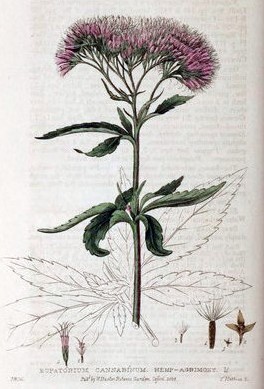
Eupatorium cannabinum – botanical illustration
The flowering of eupatoriums appears as elegant corymbs in pink, white, or purple, with a light and airy appearance. It begins in July, but can sometimes be delayed. However, it knows how to make up for it with its rapid and vigorous growth, ensuring a magnificent flowering until the end of summer and sometimes into October, depending on the species.
Highly melliferous, the flowers of Eupatorium attract numerous butterflies and pollinating insects, making it a valuable ally at the edge of a vegetable garden. This robust and hardy perennial also does wonderfully in borders or large beds, either alone or accompanied by other plants suited to moist soil. The taller species, such as the purple eupatorium reaching 2 m, are particularly perfect for the back of a border. In contrast, Eupatorium coelestinum, at 80 cm high, should be highlighted at the edge of a border in a natural garden.
Easy to grow, eupatorium establishes itself easily in all our regions, provided the soil remains moist, even during the driest summers. Aside from this requirement, essential for beautiful flowering, this perennial requires no maintenance and even self-seeds spontaneously. Once dry at the end of autumn, all you need to do is cut it back and wait for the following spring!

Different foliage of eupatorium: Eupatorium perfoliatum, Eupatorium rugosum ‘Chocolate’, Eupatorium cannabinum ‘Plenum’, Eupatorium rugosum, Eupatorium maculatum ‘Atropurpureum’.
Species and varieties
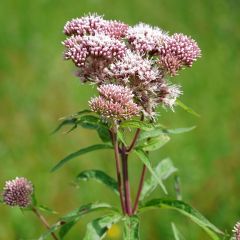
Eupatorium cannabinum Plenum
- Flowering time September to November
- Height at maturity 1,50 m

Eupatorium coelestinum
- Flowering time August to November
- Height at maturity 80 cm
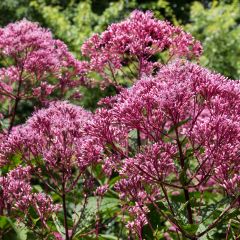
Eupatorium maculatum Atropurpureum
- Flowering time September, October
- Height at maturity 2 m

Eupatorium perfoliatum
- Flowering time September to November
- Height at maturity 1,10 m
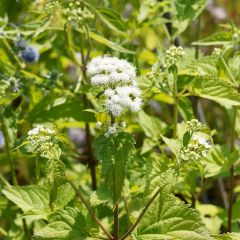
Eupatorium rugosum Braunlaub
- Flowering time September, October
- Height at maturity 1 m
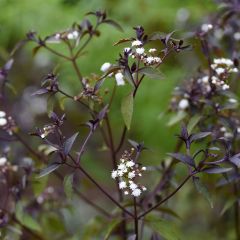
Eupatorium rugosum Chocolate
- Flowering time October, November
- Height at maturity 1,20 m
Discover other Eupatorium - Boneset
View all →Available in 2 sizes
Available in 2 sizes
Available in 1 sizes
Available in 1 sizes
Available in 2 sizes
Available in 1 sizes
Available in 1 sizes
Available in 1 sizes
Available in 1 sizes
Available in 1 sizes
Planting of eupatorium
Where to plant it?
Eupatorium is a very hardy (down to -15°C) perennial that adapts to all our climates, provided it has a cool, even moist soil that never dries out. In dry soil, it wilts quickly and its foliage takes on a burnt appearance. Although it prefers heavy, clayey soils, it can thrive in any ordinary, cool, and well-drained soil.
Aside from this requirement, Eupatorium is not difficult. The pH of the soil or air pollution does not matter; it easily settles in all gardens. In urban areas, it is particularly perfect for adding a slightly wild touch and promoting biodiversity. Eupatorium is indeed very melliferous and will undoubtedly attract pollinating insects, especially butterflies.
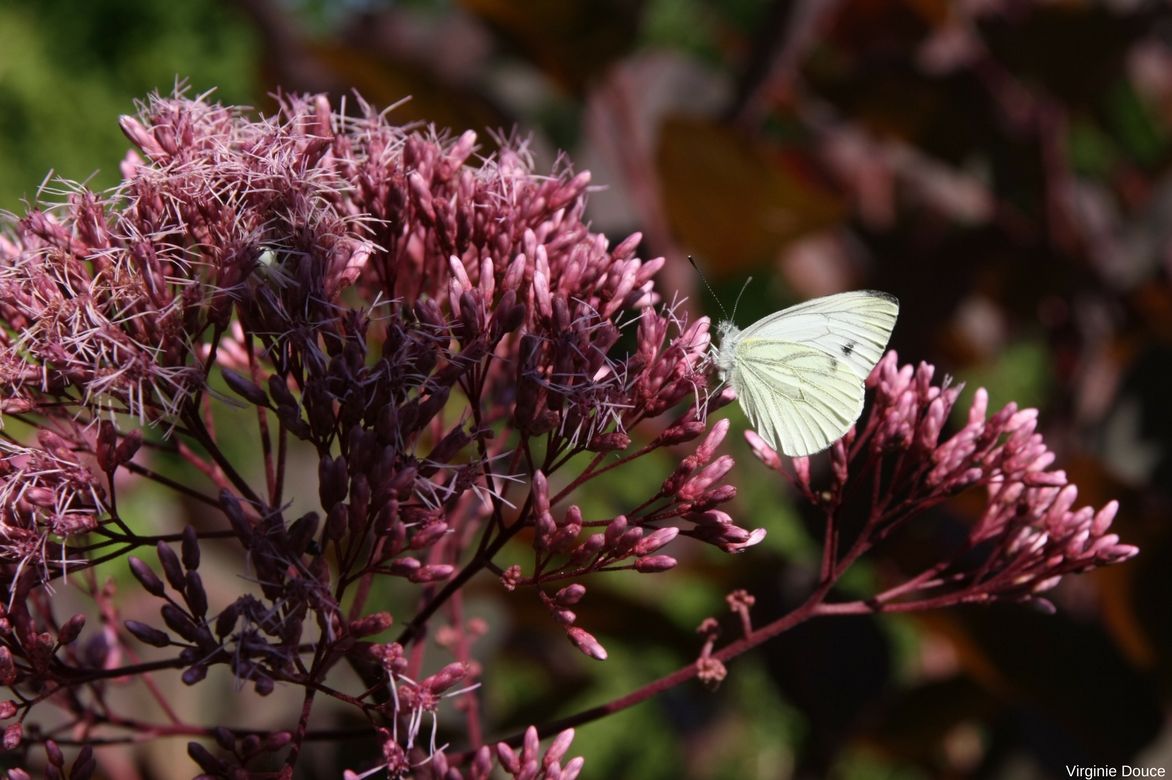
The flowers of Eupatorium are very melliferous.
For vibrant colours and a beautiful flowering, choose a well-sunny location for it. However, Eupatorium is also a plant naturally found at the forest edge, so it does not fear partial shade.
We do not recommend growing it in pots, as this does not do justice to its bushy habit and slightly wild look. Eupatorium, on the other hand, works wonders in a border, as a backdrop or to add relief, but also in a flowering meadow, a flowerbed, or even as a solitary plant. Its preference for moist soils also makes it an ideal candidate for the edge of a bank or pond.
When to plant Eupatorium?
Eupatorium is ideally planted between February and April. Be careful if you live in a montane climate, as the young shoots may be sensitive to the last severe cold snaps. It can also be planted in autumn, between September and November, especially in the warmer, Mediterranean-type climates.
How to plant it?
- Prepare the soil by loosening it deeply with a fork.
- Amend your soil by mixing it with well-decomposed compost.
- Dig a hole three times the size of the root ball.
- Place the plant, ensuring that the collar (the junction point between the roots and the stem) is level with the soil surface.
- Firm the soil and water generously.
We recommend a planting density of 3 to 5 plants per m² to ensure a lovely bushy effect.
Care
Cultivated in cool, rich, and clayey soil, the eupatory requires no maintenance. In ordinary soil, a small addition of compost in early spring will encourage its recovery.
Be careful, in dry soil, the eupatory does not thrive and wilts quickly. Water regularly to maintain a constant freshness at the base of your plants. Mulch to limit water evaporation and thus reduce the need for watering. An excellent way to recycle your grass clippings, for example!
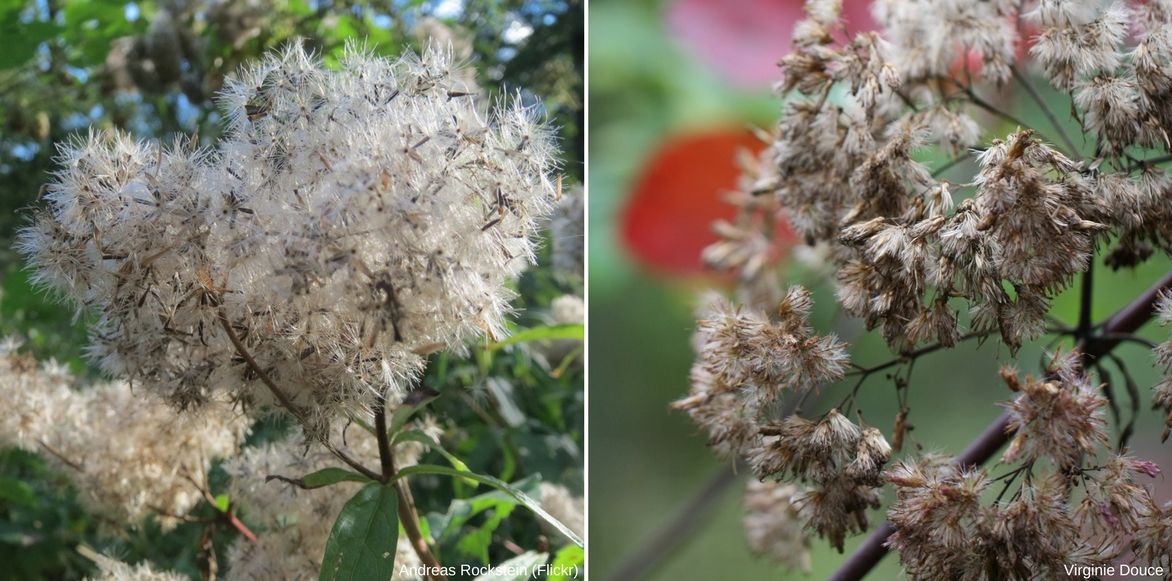
Dried clumps: Eupatorium cannabinum / Eupatorium maculatum ‘Atropurpureum’.
In any case, cut back the dry clump in late autumn-early winter. This operation helps to maintain a compact habit in the following spring. Cut each plant to 10 cm above the soil when it is no longer decorative, between November and January. No need to mulch, it withstands cold down to -15°C.
The eupatory is known for self-seeding very easily. This is a trait you can take advantage of in a flowering meadow, but it can be a concern in a flower bed. However, there is nothing alarming; the young plants can be easily pulled out, so it is easy to get rid of them if they start to become overcrowded. You can also prevent spontaneous sowing by removing faded flowers as they appear. This will also stimulate the appearance of new flowers.
In spring, watch out for slugs, which are fond of all the young shoots that emerge. If you face an invasion of gastropods, treat with a slug control product suitable for organic farming, such as Ferramol. Other than that, this perennial is resistant to both diseases and pests.
Multiplication: sowing and division
Eupatorium multiplies easily by sowing or clump division.
Sowing Eupatorium seeds
Eupatorium self-seeds readily. If you wish to transplant the young plants, wait until they are sufficiently developed, in September-October.
It is also possible to collect the seeds once the flowers are well dried. Store them in a dry, light-protected place and sow them in spring, between March and May, once the risk of frost has passed:
- Sow finely in trays using a “seed sowing” compost.
- Place the tray under a cold frame until the seedlings are about ten centimetres tall.
- Then transplant into individual buckets.
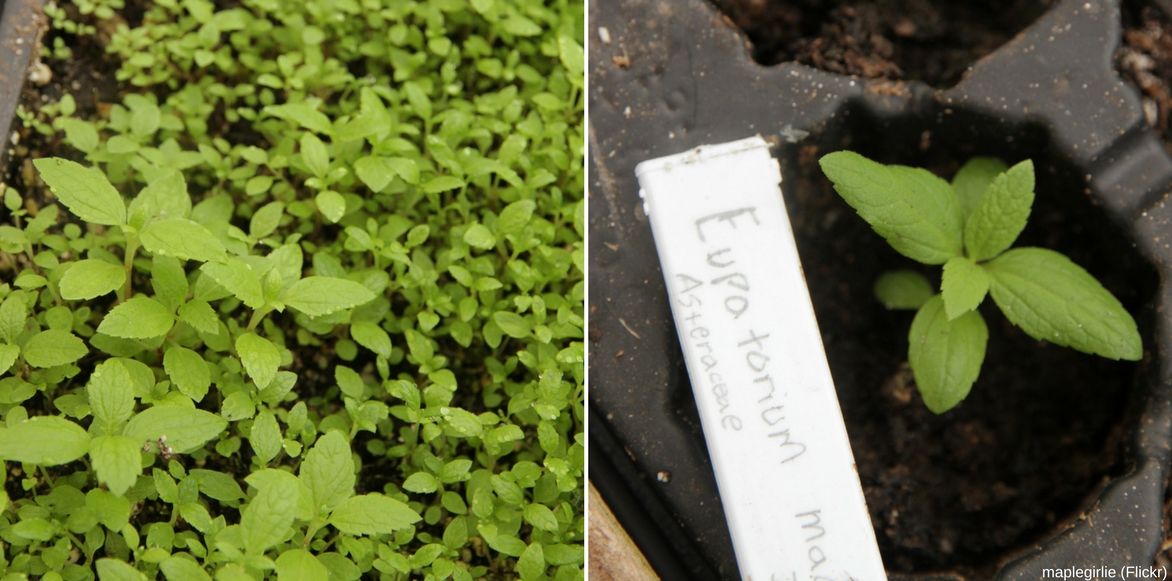
Sowing Eupatorium maculatum.
Planting out occurs in autumn, or the following spring in climates with harsh winters, particularly in mountainous areas.
Dividing Eupatorium
Eupatorium is a perennial that divides easily in the early spring, between March and April. To do this:
- Dig up the clump using a well-sharpened spade.
- Separate it into several parts, ensuring that each has sufficient roots.
- Replant immediately and water.
Associating Eupatorium in the garden
The eupatory is a perfect plant for flowering the edge of a pond, an unflooded bank, or a damp ditch. For example, choose Eupatorium cannabinum ‘Plenum’, which has a slightly wilder appearance than its relatives. Also enjoy its rustic look and expansive character by planting it in a flowering meadow where its melliferous presence will delight butterflies and other pollinators. It will thrive on its own or alongside other plants from wet areas such as loosestrifes or lysimaches.
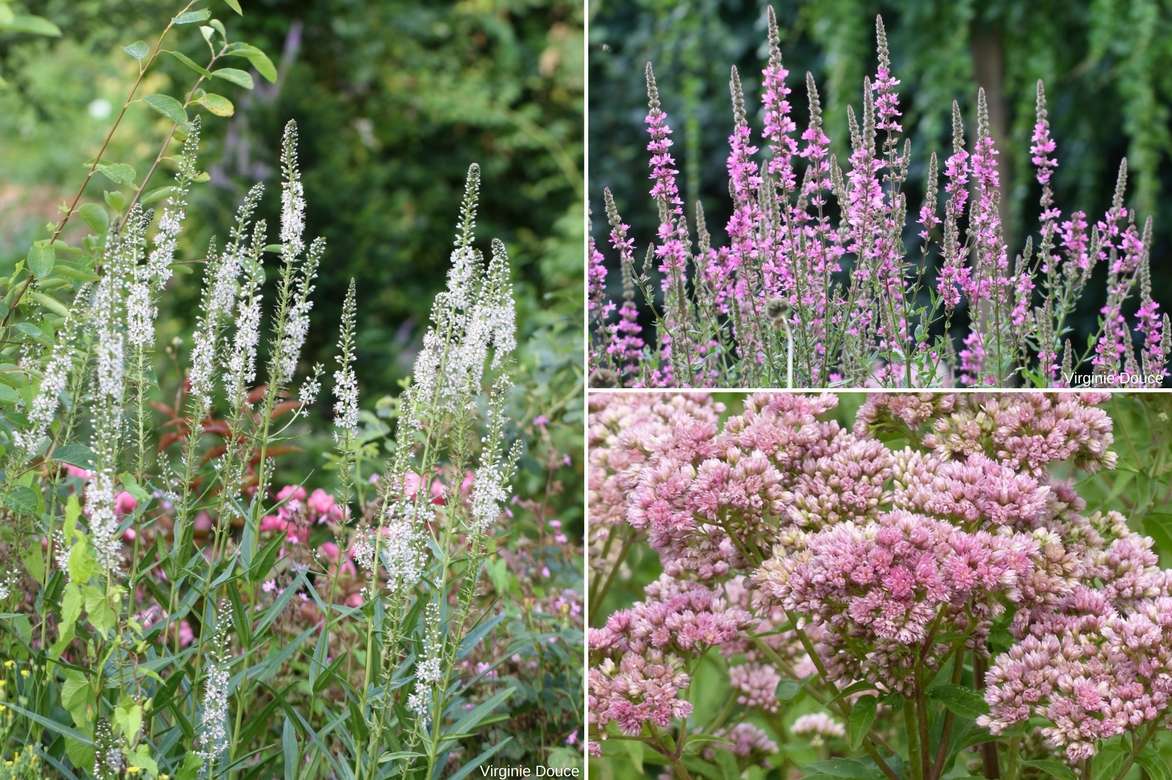
An example of a combination in damp soil: Lysimachia ephemerum, Lythrum salicaria, Eupatorium cannabinum ‘Plenum’.
Its rapid growth makes it a perfect plant for quickly creating a dense and lush backdrop. Pair the intense purple of the stems and flowers of Eupatorium maculatum ‘Atropurpureum’ with Echinacea purpurea ‘Magnus’. Add contrast and lightness with the soft white spikes of Veronicastrum virginicum var. album and the silky tufts of Stipa tenuifolia. To perfect this rustic look and give it even more depth, slip in a few young plants of Buenos Aires verbena with very airy purple flowering panicles.
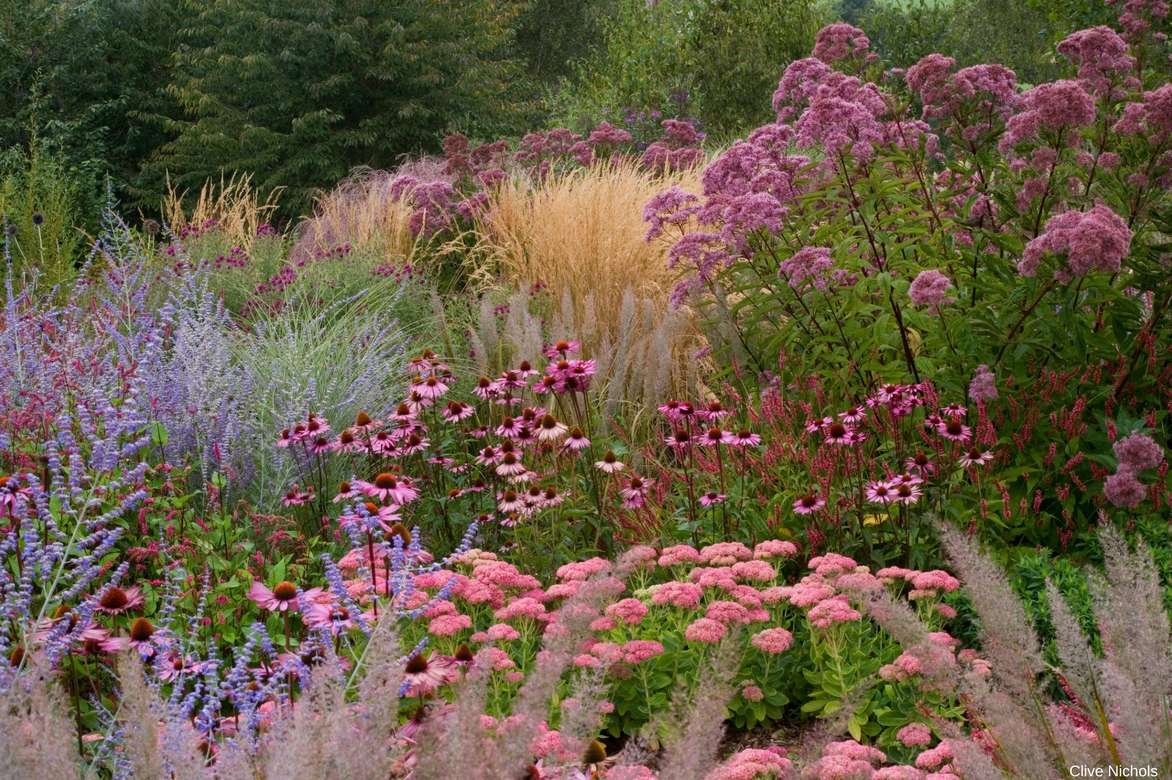
A beautiful idea for a mixed border: Sedum ‘Autumn Joy’ (syn. ‘Herbstfreude’), Echinacea purpurea, Eupatorium maculata ‘Atropurpureum’, Perovskia ‘Blue Spire’.
The exquisite hue of the foliage of Eupatorium rugosum ‘Chocolate’ is also an excellent way to highlight plants with lighter foliage, such as the anise green of a hosta. It will also contrast elegantly with white flowers. Opt for tall flowers, such as the elegant clusters of Cimicifuga.
The Eupatorium coelestinum thrives in a flowerbed with pastel colours, paired with dahlias, petunias, or asters, which also appreciate cool soils.
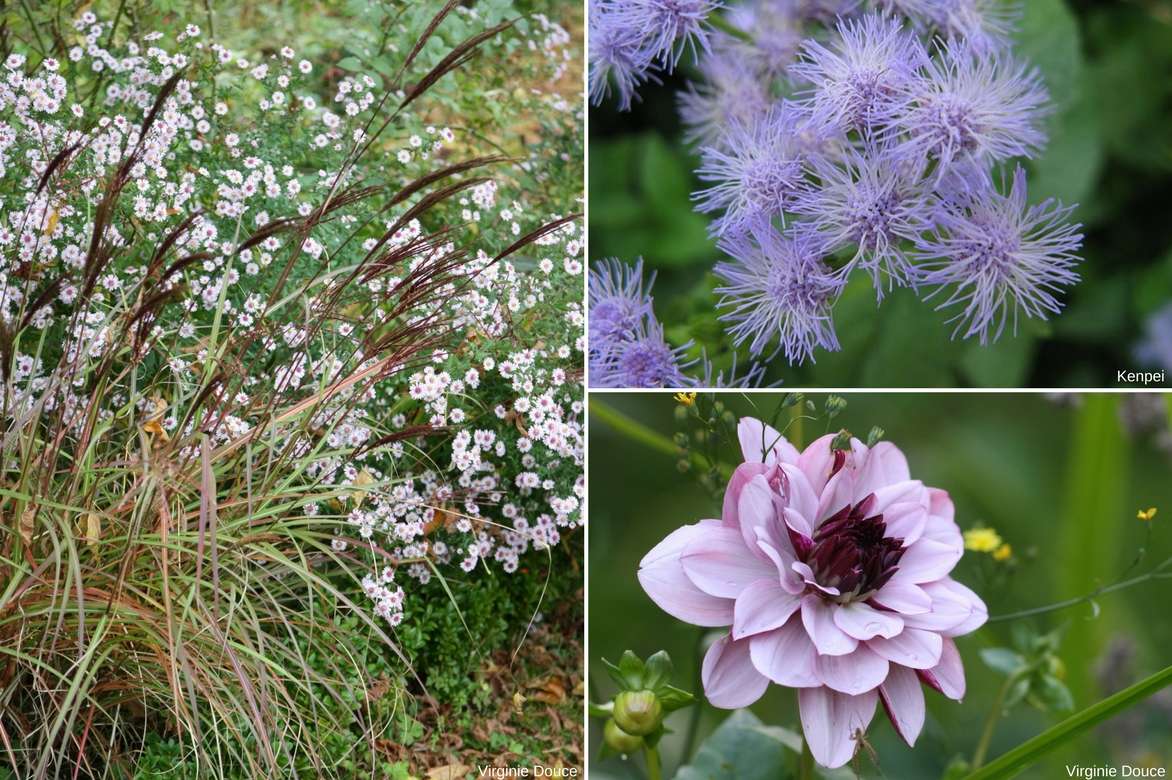
An example of a combination: Miscanthus sinensis ‘Red Chief’, Aster ‘Pink Buttons’, Eupatorium coelestinum, Dahlia ‘Crème de Cassis’.
Finally, a solitary planting will provide a beautiful focal point in your garden. Choose from the tallest varieties, which can reach up to 2 m (E. cannabinum or maculatum).
Did you know?
The eupatory is one of the emblematic plants of Piet Oudolf’s garden, the famous landscape designer of the “Dutch New Wave”. His naturalistic gardens consist of numerous varieties of perennials and grasses, selected with unparalleled artistry to create a backdrop of a “meadow garden” in perpetual evolution.
In Hummelo, among the many varieties cultivated in this naturalistic Eden, Eupatorium maculatum ‘Riesenschirm’ rises to its full height (2 m) and offers a most exquisite display with its large inflorescences of deep purple-pink.
Historical anecdote
The eupatory gets its name from Mithridates VI Eupator, a king who reigned long ago in Persia, around 110 BC. The monarch, fearing he would be poisoned and convinced of the immunity conferred by his antidote, is said to have regularly consumed a preparation made from hemp agrimony (Eupatorium cannabinum). However, there is no evidence that the plant in question was not confused with agrimony, which has strong formal similarities, in addition to many medicinal properties.
Useful resources
Discover our wide range of eupatoriums!
Discover our ideas for associating eupatoriums in the garden.
Join us for a visit to Piet Oudolf’s garden in Hummelo.
Also discover the Buenos Aires verbena and its very airy flowering.
Frequently asked questions
-
My eupatorium is struggling to grow this spring, what should I do?
The growth of eupatorium can suffer from soil that is too dry or too poor. Add well-decomposed compost and water very regularly to ensure that the soil never dries out. Also, be wary of slugs, which enjoy the tender young shoots.
-
Is the eupatory a good choice for me, living in the mountains where frosts are frequent in winter?
Eupatorium displays excellent hardiness and establishes easily in all our regions. If you are concerned about very severe prolonged frosts, leave the aerial parts in place during winter, as they will protect the stump. Applying a mulch in winter is possible, but be careful that it does not become waterlogged.
- Subscribe!
- Contents
































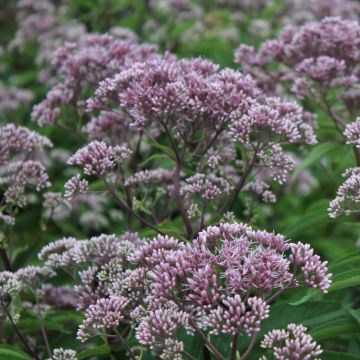
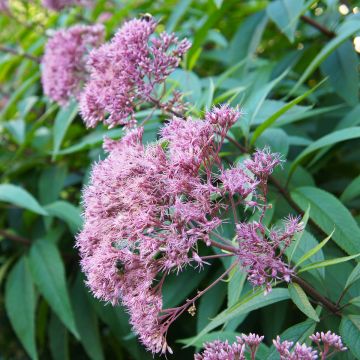

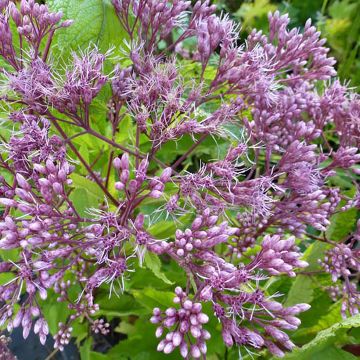


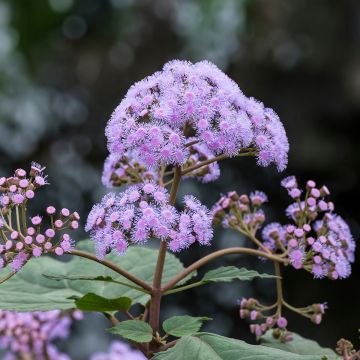
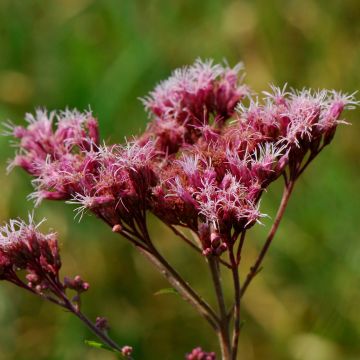
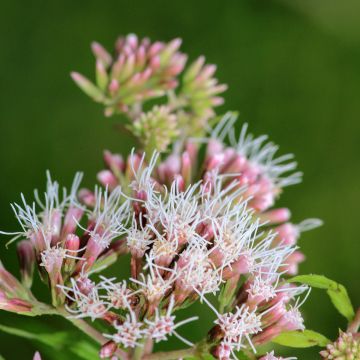
Comments